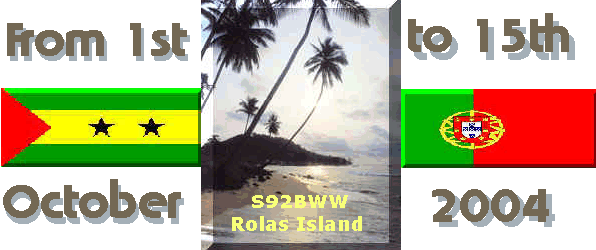


|
|
What is North West Africa Adventure? Propagation Over View and Frequencies Others Stations from S.Tomé e Principe
|
Why Rolas Island? During a Contest It's important to be "Punch" On a DX´pedition it's important have strong signal ! But more important is to be there!... On this project we need to be There just to have a normal station. A line,
an island, a meeting of different origins and cultures, and with a history
shaped by an environment of great natural beauty that appeals in
a unique way to all visitors who set foot here. All your senses are
amplified, in a space confined only by the vastness of the ocean and
with time bounded only by the limits of you memory and your own imagination. Rolas Island Resort has managed to combine these agricultural activities perfectly with its tourist function, while simultaneously preserving and presenting a rich historical, architectural and cultural heritage. The
S.O.S. Turtles Project is yet another initiative that offers the
visitor a different Rolas
Island Resort thus offers tourism on a wide scale. Besides all the marine
activities that have been organised for you, there are also a bar and a
restaurant, with traditional music and cuisine, sports fields, a 2
300 m2 swimming pool with two sections (one for children and the other for
adults), and a pool bar.
TAP Air
Portugal and Air Luxor flies weekly from Lisbon at attractive rates. There are
also daily flights from São Tomé to neighbouring African
countries, including Gabon, Côte d'Ivoire, Angola, Nigeria, and
Equatorial Guinea.
Porquê o Ilhéu das Rolas? Situado a sul da Ilha de São Tomé, o Ilhéu das Rolas possui excelentes infraestruturas turísticas , proporcionando aos visitantes uma variedade de escolhas em pleno Equador. Assim, além dos desportos náuticos os turistas podem usufruir duma paisagem paradisíaca única. O povo São Tomense caracteriza-se pela sua hospitalidade tornando a todo o viajante uma relação de franca amizade .
A Linha do Equador atravessa o Ilhéu das Rolas, dando a possibilidade ao visitante estar no dois hemisférios na mesma altura no mesmo instante. Existem pequenas ilhotas ou ilhéus que completam este Arquipélago , junto a S.Tomé temos: Ilhéu das Rolas, o Ilhéu das Cabras e as sete pedras junto a ilha do Príncipe temos: o Ilhéu Bombom, o boné de jockei, a Pedra da Galé, as Tinhosas e os Mosteiros.
As ilhas de São Tomé e Príncipe ficam situadas no golfo da Guiné, a pouco mais de 320 Kms da costa ocidental africana; o Equador "passa" pelo ilhéu das Rolas, a Sul de São Tomé , e a ilha do Príncipe situa-se a 2º de latitude Norte e a 140 NE da ilha principal do arquipélago, São Tomé (857 Km2). As ilhas fazem parte, assim como Pagalu (Anno Bom) e Nguema (Fernando Pó), de um alinhamento vulcânico que, partindo do sul do lago Chade, se prolonga segundo a bissectriz do golfo da Guiné, por mais de 2.000 Kms. Na ilha de São Tomé as maiores altitudes encontram-se no centro oeste.. A curva dos 2000 Mts envolve o maior maciço vulcânico fortemente dissimétrico, caindo abruptamente para o mar, a poente aonde se encontram os picod mais elevados: Pico (2024 mts) e Chaves (1636 mts).
A ilha do Príncipe, com os seus 114 km2, pode dividir-se em duas áreas bem distintas; o sul, de relevo vigoroso e complexo, quase inacessível, culmina a 984 mts. no pico do Príncipe mais ou menos no centro da ilha. O arquipélago foi descoberto pelos navegadores Portugueses respectivamente a ilha de São Tomé em 21 de Dezembro de 1470 e um ano mais tarde a 17 de Janeiro as caravelas Portuguesas ancoraram ao largo do Principe. As ilhas estavam desertas, sendo o seu povoamento oficial em 1485 quando o rei D.João II doou a ilha de S.Tomé ao Fidalgo D. João de Paiva. Em meados do século XVI, usando escravos africanos, os colonos fizeram daquela ilha o maior produtor de açucar do Mundo.
Algumas especiarias são originárias daquelas ilhas e algumas culturas agrícolas levadas de Portugal tiveram ali sucesso como a vinha , o trigo e mesmo a figueira. Mas sem dúvida foi na cultura do café e do cacau que no século XIX obteve as maiores produções.
Em 1960 na sequência dos movimentos de libertação das ex colónias portuguesas surge o Comité do Movimento de Libertação de São Tomé e Principe. A partir de Abril de 1974 após o golpe militar que em Portugal derrubou a ditadura, o governo Português reconhece esse Movimento de Libertação como representante legítimo do povo santomense. A 12 de Julho de 1975 nasceu a República Democrática de S.Tomé e Príncipe.
Beaming heads:
[ Index |Porquê o Ilhéu das Rolas | Aproveita o DX | Operador | Outras Expedições | Qsl | Patrocinadores | Propagação Frequências | Notícias ] Go to Bottom
Back to Top Home
Web-designer MACM© Copyright Last changed: Março 31, 2005
|